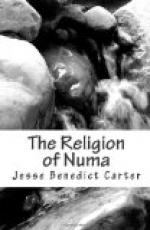THE RELIGION OF NUMA
Rome forms no exception to the general rule that nations, like individuals, grow by contact with the outside world. In the middle of the five centuries of her republic came the Punic wars and the intimate association with Greece which made the last half of her history as a republic so different from the first half; and in the kingdom, which preceded the republic, there was a similar coming of foreign influence, which made the later kingdom with its semi-historical names of the Tarquins and Servius Tullius so different from the earlier kingdom with its altogether legendary Romulus, Numa, Tullus Hostilius and Ancus Martius. We have thus four distinct phases in the history of Roman society, and a corresponding phase of religion in each period; and if we add to this that new social structure which came into being by the reforms of Augustus at the beginning of the empire, together with the religious changes which accompanied it, we shall have the five periods which these five essays try to describe: the period before the Tarquins, that is the “Religion of Numa”; the later kingdom, that is the “Reorganisation of Servius”; the first three centuries of the republic, that is the “Coming of the Sibyl”; the closing centuries of the republic, that is the “Decline of Faith”; and finally the early empire and the “Augustan Renaissance.” Like all attempts to cut history into sections these divisions are more or less arbitrary, but their convenience sufficiently justifies their creation. They must be thought of however not as representing independent blocks, arbitrarily arranged in a certain consecutive order, not as five successive religious consciousnesses, but merely as marking the entrance of certain new ideas into the continuous religious consciousness of the Roman people. The history of each of these periods is simply the record of the change which new social conditions produced in that great barometer of society, the religious consciousness of the community. It is in the period of the old kingdom that our story begins.
At first sight it may seem a foolish thing to try to draw a picture of the religious condition of a time about the political history of which we know so little, and it is only right therefore that we should inquire what sources of knowledge we possess.
There was a time, not so very long ago, when under the banner of the new-born science of “Comparative Philology” there gathered together a group of men who thought they held the key to prehistoric history, and that words themselves would tell the story where ancient monuments and literature were silent. It was a great and beautiful thought, and the science which encouraged it has taken its place as a useful and reputable member of the community of sciences, but its pretensions to the throne of the revealer of mysteries have been withdrawn by those who are its most ardent followers, and the “Indo-Germanic




